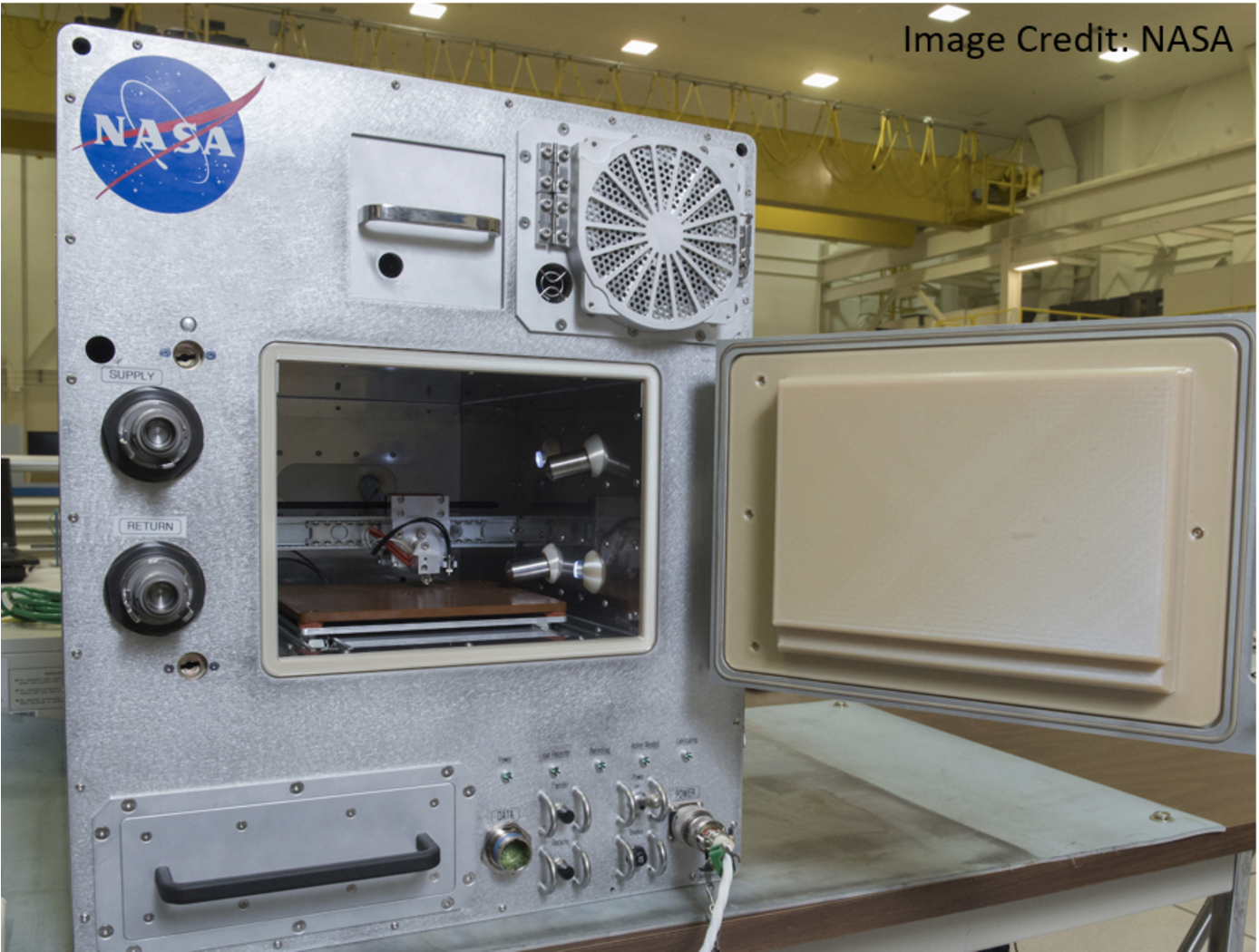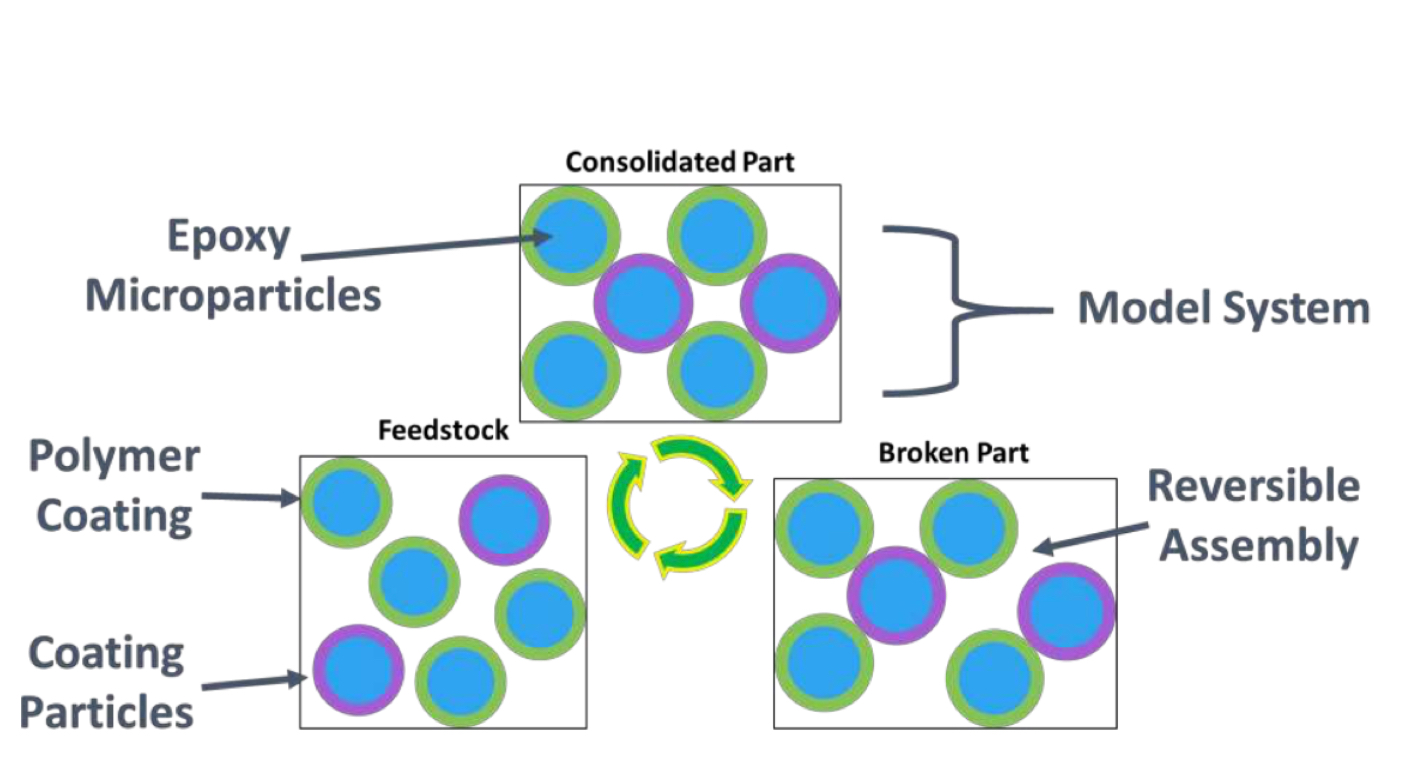Recyclable Feedstocks for Additive Manufacturing
manufacturing
Recyclable Feedstocks for Additive Manufacturing (LAR-TOPS-337)
On-Demand Article Fabrication with Polymer-Coated Epoxy Microparticles
Overview
Innovators at the NASA Langley Research Center have developed a manufacturing technique to generate recyclable feedstocks for on-demand additive manufacturing. Additive manufacturing is a rapidly advancing art with significant recent improvements in starting materials. One common limitation has been that produced articles cannot be recycled without substantial energy costs. Development of a manufacturing technique that can generate precise, mechanically robust articles that could be reverted to feedstock for use in subsequent article manufacturing would be highly desirable for applications including long duration extra-terrestrial exploration mission planning. NASA's new manufacturing technique uses polymer-coated epoxy micro-particle systems as a recyclable feedstock material that can be used not only for in-space additive manufacturing during long-term human spaceflight but also for a wealth of applications on Earth. The resulting articles are more chemically and mechanically robust compared to the state-of-the-art materials used for most 3D printing applications.
The Technology
NASA's new technique for generating recyclable feedstocks for on-demand additive manufacturing employs the high-yield reversibility of the Diels-Alder reaction between maleimide and furan functionalities, utilizing the exceedingly favorable interaction between specific chemical functionalities, often termed "click reactions" due to their rapid rate and high efficiency. Integration of these moieties within a polymer coating on epoxy microparticle enables reversible assembly into macroscopic, free-standing articles. This click chemistry can be activated and reversed through the application of heat. Monomer species can be used to incorporate these functionalities into polyimide materials, which provide excellent mechanical, thermal, and electrical properties for space applications. Copoly (carbonate urethane) has been shown to be a viable coating material in the generation of polymer-coated epoxy microparticle systems and is amenable to being processed through a variety of approaches (e.g., filaments and slurries for 3D printing, compression molding, etc.). The polymeric materials are grown from the surfaces of in-house fabricated epoxy microparticles. The thermal and mechanical properties of the microparticles can be readily tuned by changes in composition.
There are a number of potential applications for this NASA technology ranging from use of these materials for recyclable/repurpose-able articles (structural, decorative, etc.) to simple children's toys. More demanding uses such as for replacement parts in complex industrial systems are also possible. For long term space missions, it is envisioned that these feedstocks would be integrated into secondary spacecraft structures such that no additional concerns would be introduced due to in-space chemical reactions and no additional mass would be required.


Benefits
- Recyclable feedstock: materials can be "un-clicked" at elevated temperatures, enabling a return to feedstock for subsequent fabrication of a new part
- Tunable properties: materials could be used to generate feedstock for 3D printing applications that have tunable thermal and mechanical properties for various applications including processing in facilities as simple as a home kitchen (i.e., hot water)
- Robust material: the composition is derived from the urethane and carbonate containing species, so parts created from the feedstock would be much more chemically and mechanically robust compared to the state-of-the-art ABS and PLA materials used for most 3D printing applications
Applications
- Aerospace: in-space additive manufacturing techniques to enable on-demand generation of mission-critical articles (tools, infrastructure, etc.)
- Composites: creation of materials with tunable thermal and mechanical properties
- Consumer goods: reversible 3D printed parts that can be processed in simple facilities
- Manufacturing: recyclable feedstock for additive manufacturers
- Military: in-field generation of tools for military operations
- Oil and gas: replacement parts for oceanic oil drills
- Power: replacement parts for wind turbines
|
Tags:
|
Similar Results

Fully Automated High-Throughput Additive Manufacturing
The technology is a method to increase automation of Additive Manufacturing (AM) through augmentation of the Fused Filament Fabrication (FFF) process. It can significantly increase the speed of 3D printing by automating the removal of printed components from the build platform without the need for additional hardware, which increases printing throughput. The method can also be leveraged to perform automated object testing and characterization. The method includes embedding into the manufacturing instructions methods to fabricate directly onto the build platform an actuator tool, such as a linear spring. The deposition head can be leveraged as a robotic manipulator of the actuator tool to bend, cock, and release the linear spring to strike the target manufactured object and move it off the build platform of the machine they were manufactured on. The ability for an object to 'fly off of the machine that made it' essentially enables automated clearing of the processed build volume. The technology can also be used for testing the AM machine or the feedstock material by successively fabricating prototypes of the manufactured object, and taking measurements from sensors as the actuator strikes the prototype. This provides automated testing for quality control, machine calibration, material origins, and counterfeit detection.

Additive Manufacturing Model-based Process Metrics (AM-PM)
Modeling additive manufacturing processes can be difficult due to the scale difference between the active processing point (e.g., a sub-millimeter melt pool) and the part itself. Typically, the tools used to model these processes are either too computationally intensive (due to high physical fidelity or inefficient computations) or are focused solely on either the microscale (e.g., microstructure) or macroscale (e.g., cracks). These pitfalls make the tools unsuitable for fast and efficient evaluations of additive manufacturing build files and parts.
Failures in parts made by laser powder bed fusion (L-PBF) often come when there is a lack of fusion or overheating of the metal powder that causes areas of high porosity. AM-PM uses a point field-based method to model L-PBF process conditions from either the build instructions (pre-build) or in situ measurements (during the build). The AM-PM modeling technique has been tested in several builds including a Ti-6Al-4V test article that was divided into 16 parts, each with different build conditions. With AM-PM, calculations are performed faster than similar methods and the technique can be generalized to other additive manufacturing processes.
The AM-PM method is at technology readiness level (TRL) 6 (system/subsystem model or prototype demonstration in a relevant environment) and is available for patent licensing.

Polymer Composite Material
The Polymer Composite Material provides a method for using comingled plastics in a way that is not greatly impacted by changes in composition. Comingled plastics are used as a combination filler/binder material where low melting plastics are converted into binders with higher melting plastics serving as filler and structural reinforcements. The Polymer Composite Material is made by feeding the source materials into an extruder - a solid polymeric binder at a first feed rate and a solid filler at a second feed rate. The extruder (a) melts the solid polymeric binder, (b) mixes the melted solid polymeric binder with the solid filler, and (c) extrudes an extrudate of the solid polymeric binder and solid filler to form the composite material. The composite material has a binder to filler ratio determined by the first feed rate and second feed rate. The solid filler may be granular glass and the solid polymeric binder may be at least one of polypropylene, polyethylene, polyvinyl chloride, and polyethylene terephthalate. The material can be created in a range of densities using foaming techniques.

3D Construction of Biologically Derived Materials
Once genes for a desired material type, delivery mode, control method and affinity have been chosen, assembling the genetic components and creating the cell lines can be done with well-established synthetic biology techniques. A 3D microdeposition system is used to make a 3D array of these cells in a precise, microstructure pattern and shape.
The engineered cells are suspended in a printable 'ink'. The 3D microdeposition system deposits minute droplets of the cells onto a substrates surface in a designed print pattern. Additional printer passes thicken the material. The cell array is fed nutrients and reagents to activate the engineered genes within the cells to create and deposit the desired molecules. These molecules form the designed new material. If desired, the cells may be removed by flushing. The end product is thus a 3D composite microstructure comprising the novel material.
This innovation provides a fast, controlled production of natural, synthetic, and novel biomaterials with minimum resource overhead and reduced pre- and post-processing requirements.

A One-piece Liquid Rocket Thrust Chamber Assembly
The one-piece multi-metallic composite overwrap thrust chamber assembly is centrally composed of an additively manufactured integral-channeled copper combustion chamber. The central chamber is being manufactured using a GRCop42 or GRCop84 copper-alloy additive manufacturing technology previously developed by NASA. A bimetallic joint (interface) is then built onto the nozzle end of the chamber using bimetallic additive manufacturing techniques. The result is a strong bond between the chamber and the interface with proper diffusion at the nozzle end of the copper-alloy. The bimetallic interface serves as the foundation of a freeform regen nozzle. A blown powder-based directed energy deposition process (DED) is used to build the regen nozzle with integral channels for coolant flow. The coolant circuits are closed with an integral manifold added using a radial cladding operation. To complete the TCA, the entire assembly including the combustion chamber and regen nozzle is wrapped with a composite overwrap capable of sustaining the required pressure and temperature loads.



